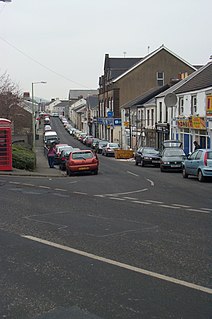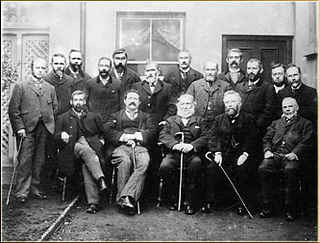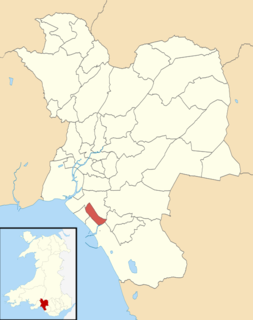
Aberdare is a town in the Cynon Valley area of Rhondda Cynon Taf, Wales, at the confluence of the Rivers Dare (Dâr) and Cynon. Aberdare has a population of 39,550. Aberdare is 4 miles (6 km) south-west of Merthyr Tydfil, 20 miles (32 km) north-west of Cardiff and 22 miles (35 km) east-north-east of Swansea. During the 19th century it became a thriving industrial settlement, which was also notable for the vitality of its cultural life and as an important publishing centre.

Aberaman is a village near Aberdare in the county borough of Rhondda Cynon Taf, south Wales. It was heavily dependent on the coal industry and the population, as a result, grew rapidly in the late nineteenth century. Most of the industry has now disappeared and a substantial proportion of the working population travel to work in Cardiff and the M4 corridor. Many residents also work in the nearby towns of Aberdare and Pontypridd.

Llwydcoed is a small village and community north of the Cwm Cynon, near the town of Aberdare, Rhondda Cynon Taf, Wales, with a population of 1,302 as of 2011 census.
Aberdare Urban District Council was a local authority in Aberdare, Wales.

The first election to the Aberdare Urban District Council was held in December 1894. It was followed by the 1896 election.
The Reverend Benjamin Evans was a Welsh Baptist minister and author, who served as Secretary of the Baptist Missionary Society in the late nineteenth century.
The first election to the Glamorgan County Council were held on 17 January 1889. Results were announced over several days. They were followed by the 1892 election. The authority, by far the largest county in Wales in terms of population, was established by the 1888 Local Government Act. The county of Glamorgan was at this time becoming heavily industrialised although some areas such as the Vale of Glamorgan remained essentially rural.
Rees Hopkin Rhys was an industrialist, landowner and prominent local government figure in the Aberdare area for much of the nineteenth century.
The second election to the Glamorgan County Council was held on 8 March 1892. The 1889 election was the first contest and the next was the 1895 election. Glamorgan County Council had been established by the 1888 Local Government Act, and the first election held in January 1889. Glamorgan was by far the largest county in Wales in terms of population. The county of Glamorgan was at this time becoming heavily industrialised, although some areas such as the Vale of Glamorgan remained essentially rural. The rise of nonconformist liberalism, especially since the 1860s, throughout Wales, had challenged the prevailing influence of the landed gentry. However, even in 1889, the traditional forces remained influential and no working men were elected to the Council. This changed in 1892 with the unopposed return of David Morgan in Aberdare and the success of Isaac Evans in Resolven.
The third election to Glamorgan County Council election was held on 4 March 1895. It was preceded by the 1892 election and followed by the 1898 election.
Griffith George (1847–1910) was a Liberal politician, businessman and a prominent figure in the cultural and religious of Aberdare and Glamorgan, Wales.
The Glamorgan County Council election, 1904 was the sixth contest for seats on this authority in south Wales. It was preceded by the 1901 election and followed by the 1907 election. Glamorgan was by far the largest county in Wales in terms of population. Glamorgan County Council had been established by the Local Government Act 1888, the first elections being held in early 1889.
The community of Aberaman, Rhondda Cynon Taf was an electoral ward for much of the twentieth century, for the purposes of electing members to Glamorgan County Council and the Aberdare Urban District Council. It currently comprises two electoral wards, Aberaman North and Aberaman South, for the purposes of electing members to the Rhondda Cynon Taf County Borough Council. Aberaman North is composed mainly of Aberaman itself while Aberaman South includes Abercwmboi, Cwmaman, Godreaman and Glynhafod.
Ogmore and Garw Urban District Council was an Urban District in Glamorgan, Wales. It was created in 1894 as a result of the Local Government Act 1894 and the 1894 Ogmore and Garw UDC election saw the election of the first members of the authority. The Council existed until 1973 and replaced the Ogmore and Garw Local Board of Health which had functioned for some years. Its boundaries were set in 1894. Initially, the Council had twelve members but this was increased some years later, as a result of the increase in population. There were two wards, namely Garw Valley and Ogmore Valley.

The electoral ward of Aberavon electoral ward includes the communities of Baglan and Baglan Bay, in Neath Port Talbot county borough, Wales. Baglan falls within the parliamentary constituency of Aberavon.
Aberdare Town was, for much of the twentieth century, an electoral ward for the purposes of electing members to Glamorgan County Council and the Aberdare Urban District Council. It currently comprises two electoral wards, Aberdare East and Aberdare West/Llwydcoed, for the purposes of electing members to the Rhondda Cynon Taf County Borough Council. Aberdare East is composed mainly of a part of Aberdare itself while Aberdare West includes the community of Llwydcoed which, for many years was itself as electoral ward.
The community of Llwydcoed, Rhondda Cynon Taf was, for much of the twentieth century, and electoral ward for the purposes of electing members to Glamorgan County Council and the Aberdare Urban District Council. Llwydcoed is no longer an electoral ward but forms part of Aberdare West/Llwydcoed electoral ward for the purposes of Rhondda Cynon Taf unitary authority elections
Blaengwawr was, for much of the twentieth century, an electoral ward for the purposes of electing members to Glamorgan County Council and the Aberdare Urban District Council. Blaengwawr no longer forms an electoral ward and is part of Aberaman.
The 1910 Glamorgan County Council election was the eighth contest for seats on this local authority in south Wales. It was preceded by the 1907 election and followed by the 1913 election.

Cardiff County Borough Council, known as Cardiff City Council after Cardiff achieved city status in 1905, was the elected local authority that administered the town and county borough of Cardiff, Glamorgan, Wales between 1889 and 1974. The county borough council was replaced in 1974 by a district council, covering part of South Glamorgan and also known as Cardiff City Council.





